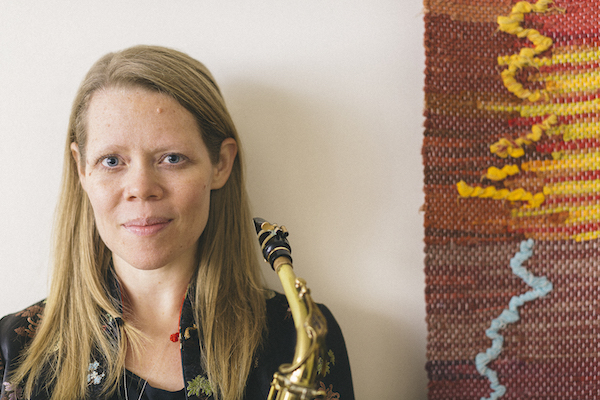Oct 28, 2025 10:47 AM
In Memoriam: Jack DeJohnette, 1942–2025
Jack DeJohnette, a bold and resourceful drummer and NEA Jazz Master who forged a unique vocabulary on the kit over his…

Caroline Davis initially developed the music on Alula with drummer Greg Saunier during Brooklyn performances.
(Photo: Jacob Hand)Caroline Davis’ latest trio album, Alula (New Amsterdam), mines the anatomical world—the title referring to an appendage on a bird’s wing that aids aerial navigation—for material that can be transformed into artistic analogs. In that respect, the project resembles the saxophonist’s previous disc, 2018’s Heart Tonic (Sunnyside), which drew on cardiology.
And like her previous release, the new effort reflects her intellectual bent: Davis holds a doctorate in music cognition from Northwestern University and lectures widely on music. Taken together, the albums point to an evolving aesthetic that draws on the spirit, if not the specifics, of her scholarly pursuits.
“I’m totally more interested in putting the science into the music,” Davis, 37, said over drinks at a Brooklyn coffee shop in June. But in balancing intellect and emotion, the edge goes to the latter. For all of Davis’ logical rigor—and her willingness to deploy it in the service of her art—she makes sure that the science informs, rather than dictates, the music’s direction.
“I want to be careful about it,” she said.
Thus, even as the 11 tracks on Alula constitute disquisitions inspired by aspects of a bird’s alula, they are also poetic journeys. Her takeoff point still has been scientific inquiry.
“I started by looking into the math related to the size of the bird and the size of the alula, and I used some of those numbers to write some of the pieces for the album,” Davis explained.
“Wingbeat,” for example, is structured according to the ratio of bones to feathers on an alula, with a top row of 23 pitches assigned to her alto saxophone and a 17-pitch bottom row assigned to Matt Mitchell’s synthesizer. The pitches never line up, making for a breathlessly disorienting flight—not least for drummer Greg Saunier, who’s best known as a member of the rock world’s Deerhoof, but also has worked with jazzworld figures like Anthony Braxton and Mary Halvorson.
“It started life as an amorphous blob,” he said of his contribution to the piece, adding that his part began to take shape as he familiarized himself with the work’s contrapuntal intricacies. “I started thinking of it as a kind of James Brown thing, incredibly regular and sort of danceable.”
“Landing,” on the other hand, was clear from the get-go. Operating within an otherworldly soundscape of soaring saxophone and lush strings synthesizer, Saunier delivers a relentless, march-like beat in 7/4. The piece, in fact, grew out of Davis’ almost mystical fascination with the number 7.
“I wanted to create this atmosphere like you were flying through space,” the bandleader said, “but I wanted to use this very specific number. There are so many equal parts inside of 7, yet it’s an odd number. It’s a prime number. It’s also this ‘lucky 7.’ I was relating it to how complicated the structure is and putting it inside a space that is beautiful and ethereal.”
The piece gains power from its spare framework, achieving maximum impact by subtle sonic shifts, rather than dramatic displays. “I remember having tears in my eyes as it was happening,” Saunier said, recalling his reaction during the December 2017 recording session at Figure 8 studio in Brooklyn.
Initially, the album’s music was developed by Davis and Saunier during concerts in small spaces throughout Brooklyn. Mitchell joined the two for a smattering of gigs before the tracks were laid down. Having employed Davis with his band Sprees for shows at The Stone in 2016, Mitchell was prepared for the understated profundities that awaited.
“It’s almost unassuming in a certain way,” Saunier said of Davis’ music. “It’s not like, ‘Check me out, I’m super-deep.’ But then you listen; it’s a very personal exploration of things you thought you knew.”
Davis’ scientific explorations lately have turned to neurons. For that project, she’s introduced a kinetic element into her solo performances. Hopping a bit onstage, gauging how the movement alters the rush of air through her horn, Davis’ immediate goal is intellectual: “How can I move like a neuron would move at the micro level—these little chemical reactions involving potassium and sodium?”
But, like all her efforts, the ultimate objective is discovering an emotional truth: “How does it feel?” DB

Jack DeJohnette boasted a musical resume that was as long as it was fearsome.
Oct 28, 2025 10:47 AM
Jack DeJohnette, a bold and resourceful drummer and NEA Jazz Master who forged a unique vocabulary on the kit over his…

D’Angelo achieved commercial and critical success experimenting with a fusion of jazz, funk, soul, R&B and hip-hop.
Oct 14, 2025 1:47 PM
D’Angelo, a Grammy-winning R&B and neo-soul singer, guitarist and pianist who exerted a profound influence on 21st…

Jim McNeely’s singular body of work had a profound and lasting influence on many of today’s top jazz composers in the U.S. and in Europe.
Oct 7, 2025 3:40 PM
Pianist Jim McNeely, one of the most distinguished large ensemble jazz composers of his generation, died Sept. 26 at…

To see the complete list of nominations for the 2026 Grammy Awards, go to grammy.com.
Nov 11, 2025 12:35 PM
The nominations for the 2026 Grammy Awards are in, with plenty to smile about for the worlds of jazz, blues and beyond.…

Drummond was cherished by generations of mainstream jazz listeners and bandleaders for his authoritative tonal presence, a defining quality of his style most apparent when he played his instrument unamplified.
Nov 4, 2025 11:39 AM
Ray Drummond, a first-call bassist who appeared on hundreds of albums as a sideman for some of the top names in jazz…






